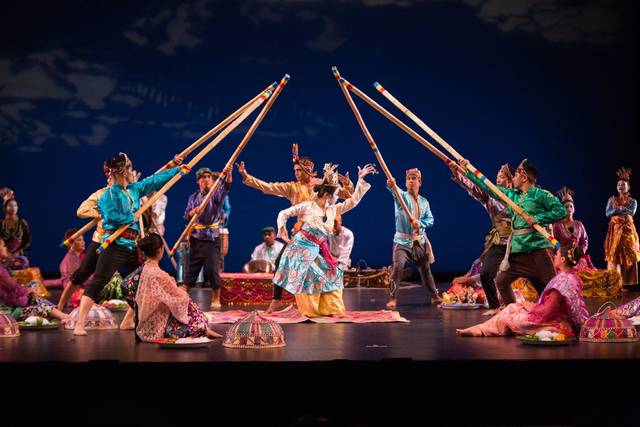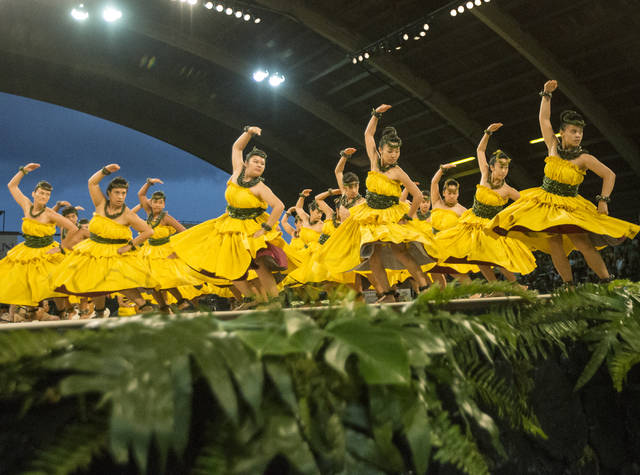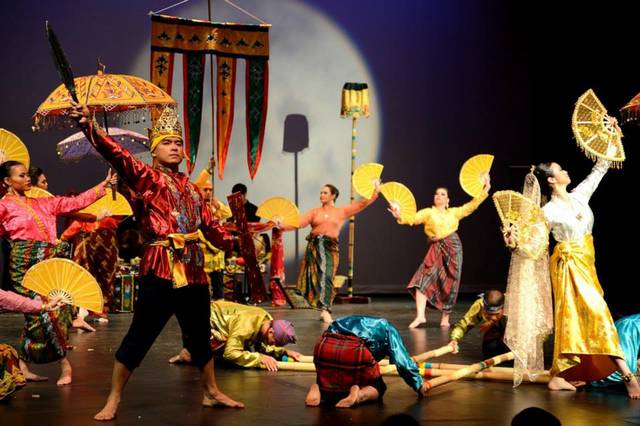The three nights of competition hula during the Merrie Monarch Festival is Hilo’s hottest ticket of the year, but some of the festival’s finest entertainment is free of charge.
Wednesday’s night’s Ho‘ike features all the pomp and pageantry of the hula competition, starting at 6 p.m. with the entrance of the Merrie Monarch Royal Court at the Edith Kanaka‘ole Multi-Purpose Stadium. And that’s just a prelude to first-rate hula plus live music and dance from the Philippines and Mexico.
A word to the wise: There are no tickets and admission to the show is free on a first-come, first-served basis. That means people line up outside the stadium hours in advance to secure their spot inside.
Hilo’s own Halau O Kekuhi, under the direction of kumu hula Nalani Kanaka‘ole, celebrates its 20th anniversary of consecutive appearances in the exhibition program with its aiha‘a style of hula and oli (chant). Their dance is a bent-kneed, powerful, bombastic style of hula that springs from the eruptive volcano persona Pele and Hi‘iaka, characteristic of Hawaii Island’s creative forces.
According to Kanaka‘ole, the halau’s performance will center on Hi‘iakaikapoliopele’s travels through Kohala.
“At first, there will be mele that references an earlier migration of the Pele clan, showcasing the environmental impact of the battle of Pele and Namakaokaha‘i while sailing for Hawaii with the Kohala coast in sight. Hi‘iaka learns of this ‘history of Pele’ as she heals the kahuna Malaeha‘akoa on Kauai, the keeper of the history of Pele’s migration,” she said.
The opening oli will feature “Ike Ia Kaukini He Lawai’a Manu” and “A Koa‘ekea I Pueohulunui.” Kanaka‘ole said Kaukini “is the bird catcher and native to the cliffs of Hulaana.”
Hi‘iaka enters Kohala at Mahiki, known today as Mud Lane, the grassy plains between Honokaa and Waimea, to battle Mahiki, the mo‘o.
“The mele provides perfect imagery, describing the winds and rains of the area that funnel through Waimea, down to Kawaihae, Puako, Lahuipua‘a, and as far as ‘Anaeho‘omalu. The hula reflects the beauty and force of these winds and accompanying rains with the feathered gourd,” Kanaka‘ole explained. “From Mahiki, Hi‘iaka travels above the valleys, over the top of Pololu to Kohalaloko. At Pu‘uhue she battles a relative, Mo‘olauwahine with her choice of weapon: her pa‘u. For this hula, we employ the bamboo spear, her second choice of weapon. The mele speaks of Pu‘uhue and the conflicting winds with red dust cloud spirals, and a grasslands in constant movement.”
Hi‘iaka then leaves Hawaii island for Maui, offering a chant to the woman of Pu‘uepa, Mookini, before departure.
“We feature one of the older hula in our repertoire, ‘Ke Welina Mai Nei Ke Kini O Lalo,’ with a hula step called the welina featured in the entire dance,” Kanaka‘ole said. “The chant is from Waipi‘o Valley during Liloa’s time when the gods Kane and Kanaloa resided on the highest cliffs and their merriment could be heard in the valley below. This is our kunou, nod, to Waipi‘o as being the earliest environments to inspire hula, as the place where hula developed out of its beauty and the raw power incoming from the cliffs.”
Kona’s Halau Kala‘akeakauikawekiu, under the direction of Aloha Victor, also will perform, as will Na ‘Ohana O Kahikilaulani O Mexico, affiliated with Hilo’s Halau Hula ‘O Kahikilaulani, a product of international outreach by the late kumu hula Rae Fonseca. The halau, led by Aida Araceli Garcia Cruz, Brenda Marissa Morales Arzate and Esperanza Rosalinda Paredes Hernandez will perform hula and Mexican folk dances, said Luana Kawelu, the Merrie Monarch Festival president.
Parangal Dance Company of San Francisco will perform indigenous Filipino tribal dances. This the first time in Hawaii for the troupe, under the artistic direction of Eric Solano and musical direction of Major Julian.
“Parangal” is a Tagalog word meaning “tribute,” said Solano, who was born in the Philippines.
“The word became fitting for the work that we do and the advocacy that we do for the indigenous people in the Philippines,” he explained. “The Philippines has 118 indigenous groups. They have really rich cultures and traditions. It’s beautiful; it’s majestic. And we always show that part. But this time, we’re going deeper into what’s really going on there. This is not just important to us as a dance group, but also to the indigenous people, to show the world that they’re still there and they’re dealing with these kinds of things that are happening today. Tribal leaders are being killed because they’re educated and they have knowledge. This shouldn’t be happening today but it is. And we hope that with the power of dance, we can bring the message of what is going on with them today.”
The troupe will perform dances from indigenous peoples in Luzon to the north, Visayas, in the center of the island chain, and Mindanao in the south. One dance in particular, a tribute to the Ata Manobo of northeastern Mindanao, should have a special resonance, according to Solano.
“If you’re aware of what the indigenous people of Hawaii are dealing with or the indigenous people (of the mainland U.S.) are dealing with the Dakota Access pipeline, there’s a parallel with what’s happening with the indigenous people of Mindanao,” he said. “That includes mining (in ancestral domains), to their rights being taken away from them, to being pushed out from their lands. So we’re using the Ata Manobo piece to relay the message of how they take care of their land, what they teach their children and how the corporations or the paramilitary will come in and cause turmoil. It’s political, but it’s important for people to see here in the Bay Area and also for the Merrie Monarch. It’s a diverse audience and we’re really grateful that we can show this piece.”
The American-born Julian studied traditional kulintang music from an acclaimed master, Danongan “Danny” Kalanduyan, who passed away late last year. The form employs a series of horizontal and suspended gongs tuned to different pitches. Julian, whose education includes woodwind instruments and Western notation, said he first saw the native Philippine instruments, which include gongs, drums and bamboo percussion, when he was 19.
“I would see these instruments and they were kind of cool, you know,” he said. “But how do I relate to it? I don’t even speak Tagalog. But I speak music. If you cut me, I think I would bleed music. And that’s how I connect to the culture; I connect to it musically.”
Julian said the dances and music the group will bring to the Merrie Monarch are largely unknown outside their areas of origin.
“Usually, when you go to the festivals, you’ll see a dance that everyone has heard of and seen, like tinikling or sayaw sa bangko, these rural folk dances that have been popularized by the Bayanihan (National Folk) Dance Company, a group from the Philippines. I think what sets us apart is that when Eric goes back to the Philippines, his mission is not to learn another tinikling, learn another dance that everyone has seen. He asks, ‘What is it that you want to be seen? What do you want everyone to know?’
“If we didn’t do it here, to many, it would never have existed. We can bring a bit of culture of an indigenous tribe from a hillside in the Philippines to an audience in San Francisco, or here at the Merrie Monarch. What’s rewarding to me is that we’re getting the message across. We’re the voice of a group that no one’s ever heard of.”
Email John Burnett at jburnett@hawaiitribune-herald.com.








